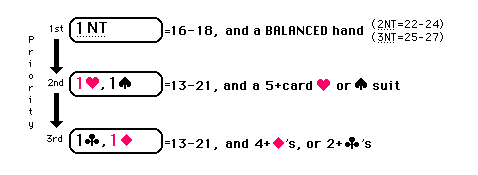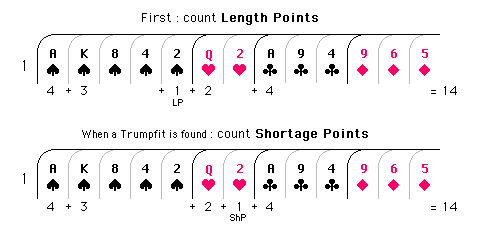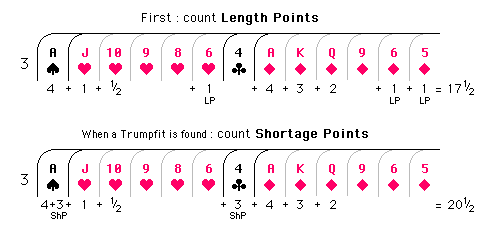(Down Fast - Up - Top)
NB 3.2 - Opening 1 in a Suit
The point ranges for all opening bids always are the High Card Points plus the Length Points (HCP + LP) in your hand.
The Opening bids of 1 in a suit are :
- 1 Spade - shows 13 - 21 points and 5-card (or longer) Spade suit.
- 1 Heart - shows 13 - 21 points and 5-card (or longer) Heart suit.
- 1 Diamond - shows 13 - 21 points and 4-card (or longer) Diamond suit.
- 1 Club - shows 13 - 21 points and 2-card (or longer) Club suit. (Comment)
The first thing to notice about these bids is their wide points range (13 - 21 points).
One in a suit opening bids are therefore called open bids, in contrast to limit bids (like the 1NT opening bid).
Secondly, one in a suit openings do not show a specific hand shape, but instead promise a minimum number of cards in one particular suit.
Here are the choices of opening bids (at the 1 level) you can make and the order of priorities in which you should select them.

- If your hand qualifies for a NT Opening bid : make that bid.
If not : consider option 2.
- If your hand qualifies for a 1 Spade or 1 Heart Opening bid : make that bid.
If not : consider option 3.
- If you have at least 13 points (but can not make one of the bids above) : bid 1 Diamond or 1 Club.
- If you have less than 13 points : do not make an opening bid, but pass instead.
Here are some typical example hands.
(Down - Up - Top)
Hand 1
You have 16 points (15 HCP + 1LP) and a semibalanced hand. This does not qualify for a 1NT opening.
However you have 5 Spades - open therefore : 1 Spades

(Down - Up - Top)
Hand 2
You have 14½ points and a balanced hand.
Not enough points for a 1NT opening and no 5-card major suit either.
You have 4 Diamonds - open therefore : 1 Diamond

(Down - Up - Top)
Hand 3
You have 21 points and a balanced hand.
Too many points for a 1NT opening and no 5-card major suit.
You have only 2 Diamonds but 4 Clubs - open therefore : 1 Club

(Down - Up - Top)
Hand 4
You have 14 points and a balanced hand.
Not enough points for a 1NT opening, no 5-card major and no 4-card Diamond suit.
You have 2 cards in Clubs : open therefore with 1 Club.

(Down - Up - Top)
Hand 5
You have 15½ points (13½ HCP + 2 LP) and an unbalanced hand.
Not suitable for a 1NT opening, but you have two 5-card major suits.
With two 5-card suits always bid the higher ranking suit first.
Open therefore with 1 Spade

(Down - Up - Top)
Hand 6
You have only 12½ points, half a point short of a minimum opening. However with a 4432 suit distribution and good honour support (more then one honour card) in three suits upgrade this hand to an Opening hand.
Open 1D.

(Down Fast - Up - Top)
NB 3.3 - Shortage Points
When you and your Partner are lucky enough to find a trump fit during the auction (8 or more cards of a suit in the combined hands) it is necessary to revaluate your hands.
As you are going to play with a trump suit, short suits (doubletons, singletons and voids) add ruffing potential to your hand.To include this aspect in your hand valuation : remove any length points in your hand from your point count, and replaced them by shortage points.
Shortage points are awarded as follows :
| Doubleton
| = 1 point
|
| Singleton
| = 3 points
|
| Void
| = 5 points
|
Converting from Length points to Shortage points usually makes little (or even no) difference in balanced and semibalanced hands. Unbalanced hands however may be upgraded significantly in strength.
(Down - Up - Top)
Example 1 shows the conversion from Length Points to Shortage points for a balanced hand. The point strength in this case remains the same.
(A balanced hand with a 4 - 4 - 3 - 2 distribution would increase 1 point in value.)

(Down - Up - Top)
Example 2 shows the conversion from Length Points to Shortage points for a semibalanced hand. The strength of the hand in this case is increase by 1 point.

(Down - Up - Top)
Example 3 shows the conversion from Length Points to Shortage points for an unbalanced hand. The point strength in this case increases by 3 points, from 17½ to 20½.

Remember : Shortage points are only counted when a trump fit between the two hands is found!
(Down Fast - Up - Top)
NB 3.4 - Raises of a 1 in a Suit Opening
(Down Fast - Up - Top)
NB 3.5 - Opener's Reply to suit Raises
When your Partner raises your opening bid of 1 Spade or 1 Heart you know that there is a trump fit in that suit.
The first thing you do (and before you reply with another bid) is to revaluate your hand using shortage point instead of length points and classify your hand :
- with 13 - 15 points = minimum opening hand
- with 16 - 18 points = strong opening hand
- with 19 - 21 points = maximum opening hand
Here are the replies you make after the various raise responses by Partner.

(Blackwood Convention)
Here are some typical examples.
In all cases you opened with 1 Heart.
(Down - Up - Top)
Hand 13
You have now 15 points (including 1 shortage point in Clubs) = a minimum opening hand.

- Pass if Partner made a single raise ---- 1H - 2H - Pass
Together you have at the most 15 + 10 = 25 points, not enough for Game.
- Bid Game if Partner made a jump raise ---- 1H - 3H - 4H
If Partner has 18+ points he will invite to Slam by bidding 5H, if so you should bid 6H, as you have maximum points (15) within your range (13 - 15).
- Pass if Partner made a Game raise --- 1H - 4H - Pass
(Down - Up - Top)
Hand 14
You have now 17 points (including 1 shortage point in Clubs) = a strong opening hand.

- Invite to Game if Partner made a single raise ---- 1H - 2H - 3H
- Slam is possible if Partner made a jump raise ---- 1H - 3H - 4NT (Blackwood Convention)
- Pass if Partner made a Game raise ---- 1H - 4H - Pass
(Down - Up - Top)
Hand 15
You have now 21 points (including 3 shortage points in Clubs) = a maximum opening hand.

- Bid Game if Partner made a single raise ---- 1H - 2H - 4H
- Bid Small Slam or 4NT if Partner made a jump raise ---- 1H - 3H - 6H (or 4NT)
- Pass or bid 4NT if Partner made a Game raise ---- 1H - 4H - Pass (or 4NT)